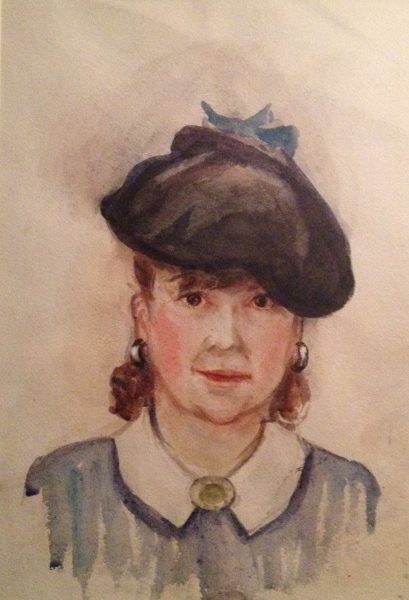
Credit: Sanborn-Hopper Family Archive.
by Juliana Roth
In a documentary video clip of Edward and Jo Hopper near the end of their lives, the film is in black and white, mostly shot in the interior of their Washington Square Park apartment, and it cuts between their studio and the liveliness of the park. The video creates a clear narrative of separation between the Hoppers and their neighbors, focusing instead on the symbiosis of 2 artists at work. As they paint in tandem, they rotate between other kinds of observation: Edward seems nearly ready to open a window for a lone pigeon lingering on their sill, Jo updates one of her many diaries.
Edward moved to the apartment when he was 31, remaining there until his death at 84. The space was sparse and centered on artmaking. NYU tried to push the Hoppers out over the years, but they battled to stay put. Now, the space is preserved under the university’s School of Social Work.
In the film, the Hoppers seem to have memorized the apartment, a tenderness and ease clear between them as they move about. The filmmaker captures essentials: a handmade easel, a printing press, a skylight, 2 windows overlooking the park. I’m drawn to the ancient stove that Jo is rumored to have burned her leg on as she posed for Girlie Show, an appliance that she once painted herself (a work that our museum, The Edward Hopper House, will soon display).
At times their marriage was hostile. Edward often processed his bitter feelings through caricatures, which he would give to Jo, one of which is included in this dispatch. Edward felt that marrying Jo had turned his life upside down, and in many ways it had. Edward resented the attention she gave to the cat and that she often resisted her presumed wifely duties.
Jo was a difficult woman. She describes in her diaries feeling like there wasn’t room for her own artistic expression in their marriage. Edward was competitive with and dismissive of her talents. She struggled to be seen, and it seems as though she internalized the societal resentment of ambitious women. She was talkative, energetic, determined; in other words, unpalatable.
Fame and artistic merit are not necessarily linked, and often speak more to elements of luck, privilege, and establishment tastes, but it does feel important here to consider who the Hoppers’ contemporaries were. Edward is compared to John Sloan, Charles Burchfield, and the American Scene painters, but their lives also overlapped with Frida Kahlo, Georgia O’Keeffe, Hilma af Klint, and Tamara de Lempicka.
With a taste for watercolors and flowers, Jo discusses in her journals and letters despising her own femininity and anything coded as female. When she painted subjects similar to Edward, sometimes decades before their marriage (like movie theaters, lone houses, sailboats), they were often portrayed with more joy, more brightness. I think in particular of one of the 2 paintings of hers preserved by the Whitney: Obituary. In the foreground, there’s a vase of dying flowers. What seems to be a woman pulls back the curtain behind them. I can’t tell if the figure is peeking out at or hiding from the flowers, but they do so with their left hand, wedding ring apparent.
Former Whitney curator, and true expert on Jo’s life, Gail Levin, notes of Jo that “after her 1968 bequest of her husband’s and her own work…the Whitney Museum of American Art, discarded all of her stretched canvases and some of her best watercolors (which she had framed). As a result, we have been reduced to knowing only a tiny fraction of Jo Hopper’s oeuvre, seen mainly in old black and white photographs.” Recently, our museum acquired dozens of Jo’s paintings that we will soon display, hoping to further restore her to the art world’s imagination.
That Jo chose to pursue the life of an artist at all feels significant to me in an era when women with creative inclinations were often guided to view art as hobby and home as masterpiece. While she had the privilege of being a white woman, and one whose father was a pianist and music teacher, her upbringing was difficult.
Jo studied at the Normal College (now Hunter College) in 1900, and in 1905 attended the New York School of Art where she studied under Robert Henri, posing for The Art Student, and met Edward for the first time. Ultimately, she spent the bulk of her later life serving as Edward’s manager, but I like to imagine her as a cartographer.
Jo drew maps of Truro and Cape Cod, displaying a deep love of place guided by her emotional experience with the land. Her maps disregard scale. The landmarks she highlights are ones with significance to them as a couple, ones where they sat together to paint and which would go on to appear on Edward’s canvas in museums across the world. I imagine the small bits of color Jo adds to the landscape to suggest a shift in elevation are known from her body; maybe as she painted her legs were still sore from a dip in a hill on an afternoon walk.
These maps are crucial to the Hopper love story. Though their paths crossed years before, Jo and Edward fell in love during the summer of 1923 at an art colony in Gloucester, MA over a shared passion for French culture, painting, and artistic ambition. Hopper was 41 and Jo was 40.
At the time of their Gloucester meeting, Edward was known more for his etchings than as a painter. A shy and introverted suitor, Edward gifted the bubbly, outgoing Jo a map of Gloucester after a long summer of them painting alone together. They’d go out for day-long excursions during which Jo taught him watercolor techniques. Ultimately, after attending a puppet show together in town, the 2 admitted that the summer they spent as friends had been a courtship. That summer altered Edward’s style, and many noted a shift in his use of light upon their return to New York. Jo took her first act as Edward’s manager and petitioned for his watercolors to be included in the Brooklyn Museum show that changed his life.
Jo’s draw to documenting their life together feels like a continuation of this remembrance of a shared place. Their lives slowly fused together in New York. Edward wrote Jo French love notes playing off of their perceived differences in style (cheer versus gloom). Their marriage was ultimately the result of an argument over where to spend the following summer as a couple: Cape Cod or Gloucester. Edward won his preference, and Jo won hers: a day-of, improvised wedding ceremony. Months after marrying, they visited Edward’s mother (Elizabeth) and sister (Marion) in Nyack, at the home where our museum now lives, who disapproved of the union.
Near the end of the video, the Hoppers leave their building together, slowly and cautiously making their way down the steps to then sit together at the park. They read from a shared newspaper and seem to discuss a headline. Edward goes to move on to the next story, but Jo is the one who turns the page.
Juliana Roth is a writer from Nyack, NY and serves the Chief Storyteller with EHH.
This series exploring the Edward Hopper archives is a collaboration between Nyack News & Views and Edward Hopper House Museum & Study Center.








